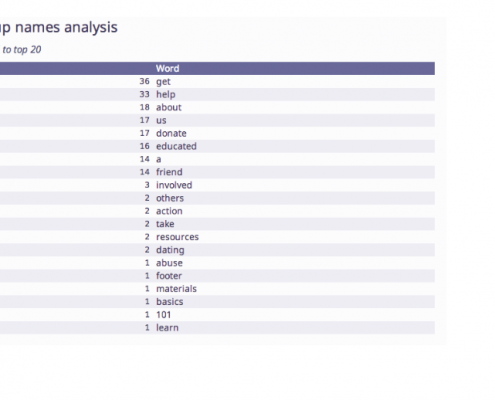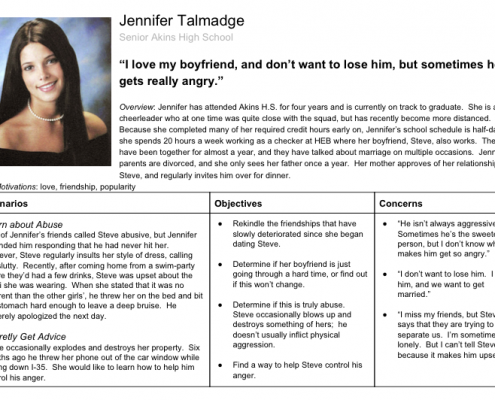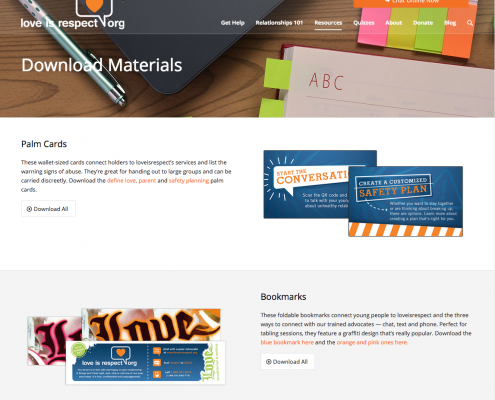Analysis and Inquiry
Content Inventory
A content inventory provides an important piece of any information architecture project: an understanding of a site’s structure and the quantity of information involved. Until an information project team understands the existing content and structure of a project, it is impossible to build a new and effective organizational scheme. Our team created a content inventory of loveisrespect.org by examining the site map and the navigation menus on the site. Through these methods we determined the scope of the site’s information, and we were able to begin redesigning the site’s architecture.
User Surveys
In preparation for this project, the National Domestic Violence Hotline (NDVH) undertook several informal surveys regarding the the loveisrespect.org (LIR) website.
Three separate survey tools were utilized:
- A survey from the LIR website, launched from the side bar. The goal of this tool was to gather feedback from the casual user of the site.
- Following chat sessions, users were given the option to provide voluntary feedback on their experience with the site.
- Advocates who helped chatters find resources were surveyed on the site’s usability and what feature or features they felt were missing.
These survey audiences also roughly correspond with the persona’s our team developed later in the project. These survey tools helped guide our redesign; we identified the following ideas and issues and incorporated them into our redesign plan:
- The overall site aesthetic was well received by both end-users and advocates.
- Accessing the chat function of the site – one of the primary functions of the homepage – was confusing due to the design and placement of the button.
- Advocates were frustrated by the poor quality of the search function, specifically when trying to share blog links with chatters.
- End-users found finding information on the site to be either “difficult” or “very difficult”
- Advocates suggested the addition of a recovered system or related posts
- While the overall response to the aesthetic was positive, respondents suggested that a more image-heavy layout would be welcomed.
- Advocate responses also overwhelmingly favored a redesign of the primary navigation system, finding it difficult and confusing to utilize with chatters.
- All surveyed users indicated a need for improvements in the mobile version of the site.
Using these broad points as a roadmap for the project, our team undertook our redesign with the following goals:
- Improve primary navigation system through user testing
- Make the chat system easier to access
- Preserve the existing aesthetic, but utilize more images in the site design.
Competitive Analysis
Competitive analysis is a key part of any information architecture project, providing project managers with detailed information on how similar organizations structure information. This might include how they structure their services to meet the needs of users, or an overview of website usability problems.
For this portion of the project, we chose four similar not-for-profit organizations. We chose the sites based on conversations with LIR staff and a basic internet search for national victim service providers that focus on a youth audience. Each similar organization features a web- or SMS-based service facilitated through their website. The following sites were evaluated:
- Polaris Project: Human trafficking text-for-help line.
- National Runaway Safeline: Serves runaway and homeless youth through web-chat, toll-free phone and other channels.
- CrisisTextLine: A catch-all, text-for-help service for teenagers facing a comprehensive range of issues.
- Trevor Project: Focused on LGBTQ youth and bullying.
While these sites address issues that differ from LIR, their missions remain relatively similar – engage young people on multiple channels, both traditional (i.e. phone) and newer, digital ones. At the same time, these sites hope to provide content that allows their users to make informed decisions about their own personal situations. We focused on three primary issues in our analysis:
- Navigation
- Access to Services (web-chat, SMS, phone, etc.)
- Search Function




























